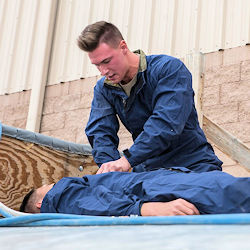Specific Training
Entry team members who are responsible for monitoring confined space atmospheres should receive specific training on the proper use of monitoring and testing instruments that will be used in the confined spaces they enter.

Include the following topics:
- the proper use of the specific equipment;
- specific calibration methods;
- specific sampling strategies and techniques; and
- definitions of PELs, TLVs, LELs, UELs, ETC. etc. (See glossary)
Training should also include the following:
- Procedures for summoning rescue or other emergency services, and
- Proper use of equipment used for communicating with entry and emergency/rescue personnel.
Real-life Scenario
The Oregon Occupational Safety and Health Division (OR-OSHA) fined a company $118,800 for multiple violations of confined space safety rules. This penalty followed an incident where two employees became unconscious in a stormwater sewer system due to low oxygen levels. The stormwater sewer system contained immediately dangerous to life and health (IDLH) oxygen levels of 12.5 percent. The situation left two employees unconscious and in need of emergency medical help. A summary of Oregon OSHA citations for violations is listed below.
- Employees who were authorized to complete permit confined space work were not supervised.
- Confined space entry team members were not properly trained.
- Confined space atmospheric and physical hazards were not identified.
- The written confined space program was inadequate.
- Proper entry permit procedures were not implemented.
- Initial testing for atmospheric hazards before entry was not conducted.
- Continuous monitoring was not completed during entry.
- Employees were not equipped with air testing and monitoring equipment.
- Employees were not equipped with ventilation equipment.
- Employees were not equipped with rescue and emergency equipment.
- The manufacturer's instructions for testing and maintaining air monitors was not followed.
- Information to supervisors, attendants and entrants entering the space about specific confined space hazards was not provided.
- Emergency procedures to remove entrants was not implemented.
Knowledge Check Choose the best answer for the question.
9-3. Entry team members who are responsible for monitoring confined space atmospheres should receive specific training on _____.
You forgot to answer the question!
